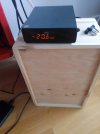Hello here I am back,
I have many things to tell you (
@DanielT @Blumlein 88 @hifiamps et al).
I have the dac ready, I remind you that it is the
Protodac project, with the two Vishay Z-Foil resistors.
To power the it I opted for the official Raspberry charger, as it is equipped with Power Delivery.
View attachment 351039
View attachment 351040
I did a lot of listening to my friend's home, where we compared:
- Protodac Without reclocker (mine)
- Protodac With Allo Kali reclocker (his)
- Allo Piano (delta-sigma) with reclocker
He made me do all
blind tests, I immediately felt the difference between the r2r and the delta-sigma, and I slightly preferred the delta-sigma.
It must be said that the r2r were not very run in, I know that they need at least 100 hours of listening and that the resistors are heated up enough.
I brought 3 songs that I know very well, which in my opinion pose problems for hi-fi systems and are found in high resolution:
- A song by a 70s prog band, Area: Arbeit macht frei: here I focused on the drums and the voice
- A song by a Berlin DJ and producer of Dub Techno music, Mike Dehnert, who works mainly with analogue synthesizers: here I focused on the bass and treble
- Bach's Brandenburg Concerto No. 5 (the one with the harpsichord): here I focused on the harpsichord which is the most difficult because it often remains "behind", and on the separation of the instruments, of this expanded organic chamber music ensemble
The substantial difference, but I'm talking about nuances, barely perceptible, was that the R2R sounded more "analog", warmer and softer sounds on the bass, sharper on the highs, while the delta-sigma seemed more "familiar" to me, probably because being from the millennial generation I'm more used to sounds like that. So everything is more detailed, more separated, colder.
However, I heard (almost) no difference between the Protodac with and without the reclocker. It must be said that the reclocker was not in the 22/24 Mhz frequency (unavailable) but the 44/48 Mhz one.
On the DAC side, the 3 songs listened to could be listened to in full without any problem from all the configurations tested.
The differences between one or the other did not affect the quality of listening, rather they gave different versions but all equally valid.
We also did numerous
tests with different amplifiers and two types of speakers (one of the two are the little sisters of my Snells). The amplifiers were all Sansui, including the 517 (which is the one I preferred), however none went beyond 65w for 8 Ohm. It also made me listen to two home-built power amplifiers in pure class A of 10w each.
After all these listenings I came to the conclusion that the Watts do not affect the clarity, on the contrary, the 10w were the best sounding on the highs, but rather I perceived the difference on songs with a lot of bass or simultaneous sounds, therefore in the Techno song and in the classic one.
The bass doesn't have the same fullness with few Watts and the instrumental separation in some passages is more mixed.
The A class was really felt in the Hi-Hats of the Prog song and in the voice, and in the violins of the classical song. But on techno music you could hear the lack of current.
As I expected, the real difference was audible when changing speakers.
After all these considerations, let's get to the point. I have almost completed the system: while I was desperately looking for an amplifier among the offers, I found the
Synthesis Roma 510 AC, an 80W integrated tube amplifier, which I had spoken about, from this old guy who was reselling it after just 1 hour of listening after it was given to him as a gift because it was "too heavy" (25 kilos!).
I took it home with 1300 euros and 2 years of warranty activated the day before.
Furthermore, the left Snell that I had been repairing for almost a year arrived, the woofers were fixed and the speaker coils were changed.
In short, I now have the full working sound system!
View attachment 351041
Let's now come to the considerations:
- It all sounds very good, I did the tests from the USB stick and using BubbleUpnP with Tidal.
- The bass is very full-bodied, I had the sound of the reverbs analyzed with RT graphs of the room by a acoustic panel company in the area, who recommended two bass traps in the back of the speakers, and two hybrid panels behind the listening point. I must say that they are necessary, they will arrive this week and I will tell you the result.
View attachment 351044
- The 3 songs I was talking about before can be heard very well, perhaps a little detail is missing from the highs which seem hidden by the lows, perhaps due to the reverb problem
Some people advised me to run everything in for a few hours of listening, especially for the KT88 tubes and the DAC.
They also told me to change the RCA source cables between the amp and the DAC. Which ones do you recommend?
And even changing the power cord of the amplifier, I noticed that the transformer makes a slight noise. What type of cable could I use?
For now the distance from the wall of the speakers is 35/40 cm, do you think this is ok?












